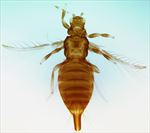Generic diagnosis
Female macropterous. Head longer than wide, strongly reticulate, not projecting in front of eyes; ocellar region not elevated, occipital ridge present; two pairs of postocular setae; maxillary palps 2-segmented. Antennae 8-segmented, segment I without paired dorso-apical setae; III and IV with sense cones simple or forked, IV with or without extra simple sense cone. Pronotum transversely reticulate, no long setae. Mesonotum entire, reticulate, anteromedian campaniform sensilla absent. Metanotum with median setae behind anterior margin, strongly reticulate medially, campaniform sensilla present. Fore wing first vein with setal row incomplete, second vein row absent; clavus with four veinal but no discal setae; posterior margin fringe cilia wavy. Prosternal ferna divided; basantra membranous and without setae; mesosternal endofurca without spinula, metasternal endofurca lyre-shaped not extending to mesosternum. Legs strongly reticulate, tarsi 2-segmented. Abdomen swollen and pyriform, tergites with entire craspedum; II anterolaterally with group of closely spaced ridges; III–VIII weakly reticulate laterally; VIII without comb; IX anterior campaniform sensilla present; X strongly tubiform, median split complete. Sternites with entire craspedum, II–VII with three pairs of posteromarginal setae; VII with two additional small setae.
Male sternites III–VII each with a transverse linear ridge-like pore plate.
Biological data
As with other members of the Panchaetothripinae, the species of this genus are all leaf-feeding.
Distribution data
Distributed across the Palaeotropics, from Africa to The Philippines, northern Australia and southern China.
Nomenclatural data
Panchaetothrips Bagnall, 1912: 258. Type species Panchaetothrips indicus Bagnall, 1912, by monotypy.
There are seven species recognised in this genus, of which two are recorded from China:
bifurcus Mirab-balou & Tong, 2016: 151.
indicus Bagnall, 1912: 258.
Relationship data
Thripidae sub-family Panchaetothripinae: this group is represented widely around the world, particularly in tropical areas, and comprises about 40 genera. Panchaetothrips is one of seven genera from Africa that seem to form a single clade within the Panchaetothripinae (Mound et al., 2001). The species of Panchaetothrips are distinguished by the presence of sculptured ridges anterolaterally on the second abdominal tergite, and the elongate, parallel-sided tenth abdominal segment (Mound & Postle, 2004).
References
Mound LA, Marullo R & Trueman JWH (2001) The greenhouse thrips, Heliothrips haemorrhoidalis, and its generic relationships within the sub-family Panchaetothripinae (Thysanoptera; Thripidae). Journal of Insect Systematics and Evolution 32: 1–12.
Mound LA & Postle A (2004) Panchaetothrips timonii sp.n. (Thysanoptera, Thripidae); first Australian record of this Old World tropical genus. Australian Journal of Entomology 43: 133–137.
ThripsWiki (2020) ThripsWiki - providing information on the World's thrips. <http://thrips.info/wiki/Main_Page>


